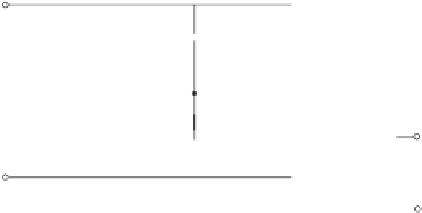Environmental Engineering Reference
In-Depth Information
be controlled by the three-dimensional space vector modulation presented in (Zhang
et al.
1997). In this strategy, the requirement of having the neutral line balanced with respect to the
two terminals of the DC power supply is entirely dropped, which leads to high voltages at
high frequencies on the two DC terminals (with respect to the neutral line). As a result, the
DC terminals may become an EMI source. An advantage of this control strategy, as compared
to the split DC link, is that the output AC voltage can be about 15% higher (for a given
DC link voltage). However, the additional neutral leg cannot be independently controlled
to maintain the neutral point and hence the corresponding control design (including the
PWM waveform generating scheme) becomes very complicated, as pointed out in (Zhang
et al.
1997).
10.4 Independently-controlled Neutral Leg
A simple and efficient topology is shown in Figure 10.3, which is the combination of the two
circuits shown in Figure 10.2. The neutral current can be controlled to flow through the
inductor so that the neutral point is maintained at the mid-point of the DC link. This allows the
phase legs and the neutral leg to be controlled independently, which means the three phases
can be controlled independently as well. Since the majority of the neutral current no longer
flows through the DC link capacitors, high capacitance is not needed, saving weight, volume
and cost. If this topology is adopted in three-level inverters, then they can also be easily
applied to supply power to unbalanced loads and/or to the grid because of the existence of a
neutral line.
This topology can also be obtained by combining a DC-DC buck converter and a DC-
DC boost converter (Jouanne
et al.
2002), where the buck converter is used to increase the
neutral point voltage and the boost converter is used to lower it. The topology can also
be obtained from a class-B chopper (Chen
et al.
2000). In both (Jouanne
et al.
2002) and
(Chen
et al.
2000), a comparator with hysteresis is used to generate pulses to operate these two
switches. Hence, the controller is non-linear. InChapters 11-13, several linear control strategies
are discussed.
V
+
R
~
C
N1
R
S
+
S
V
ave
N
V
DC
u
N
~
i
L
L
N
i
c
S
-
T
~
C
N2
i
N
R
V
-
neutral
Figure 10.3
Independently-controlled neutral leg


























Search WWH ::

Custom Search